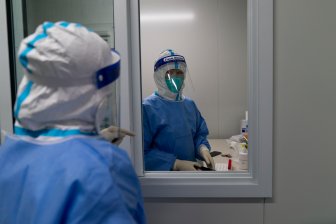Saskatoon sisters Jamille and Jacoba Taylor always knew they wanted to work together, and the COVID-19 pandemic provided that opportunity.
As a result of the new coronavirus, Jamille, 28, lost her retail job. Jacoba (26) is a personal trainer, but was also out of work.
Read more:
Saskatoon economy continues to improve during pandemic, data show
“We came up with ideas before COVID, and we just thought it was the perfect timing,” Jacoba said.
They came up with the idea for JJ’s Express Wash, a full – scale car wash equipped with an explosion of light and color, accompanied by fragrant soap and a modern vehicle transportation system.
The operation now employs 27 people, including young people and people with disabilities, which also helps attract millions of views on the car wash’s social media.
They also opened JJ’s Express Oil Change nearby.
The biggest pandemic entrepreneurship lesson Jamille said she learned was to be open-minded.
“Things are going to change so fast. Parts are not going to come in. We had to change our designs, our inventory, ”she said.
Read more:
Award-winning Saskatoon distillery branches to UK
They are currently one of the active businesses in Saskatoon that is more than the businesses that worked before the pandemic, according to findings from the Saskatoon Regional Economic Development Authority (SREDA).
A snapshot of October, November and December 2021 shows, according to SREDA, that the city’s economy has recovered to 85.6 percent of what it was before the pandemic. The findings are an improvement of 79.3% the previous quarter.
One of the biggest factors in the assessment was Saskatoon’s improved unemployment rate. The city has also benefited from strengths in sectors such as manufacturing, wholesale and retail, along with technology and innovation, according to SREDA CEO Alex Fallon.
“We’ve also seen a bit of a recovery in the mining sector, with good prices for uranium and potash,” Fallon said.
Read more:
Ottawa launches new Prairie Economic Development Agency
Although Saskatchewan’s first Omicron case arrived in early December, Fallon said the findings were based primarily on a time when the variant had not completely swept through the city.
“We can expect this indicator to decline in the coming months,” Fallon said.
The analysis also found that airport passenger traffic fell below the halfway to recovery mark. Hotel occupancy has also declined, and only appears to have worsened in January.
Jim Bence, CEO of Hospitality Saskatchewan, said hotels benefited from the Crop Production Show held earlier this month, but the low occupancy rate was “really difficult” – between 25 and 30 percent.
Some large downtown hotels have monthly fixed costs between $ 200,000 and $ 250,000, Bence said in an interview.
“So when you run with that 30 percent occupancy. . . man, you’re upside down. You lose money, ”he said.
To conduct its evaluation of the economy, SREDA relies on data from Statistics Canada, the Conference of Canada Conference, the International Monetary Fund and industry associations.
View link »
© 2022 Global News, a division of Corus Entertainment Inc.
Reference-globalnews.ca

